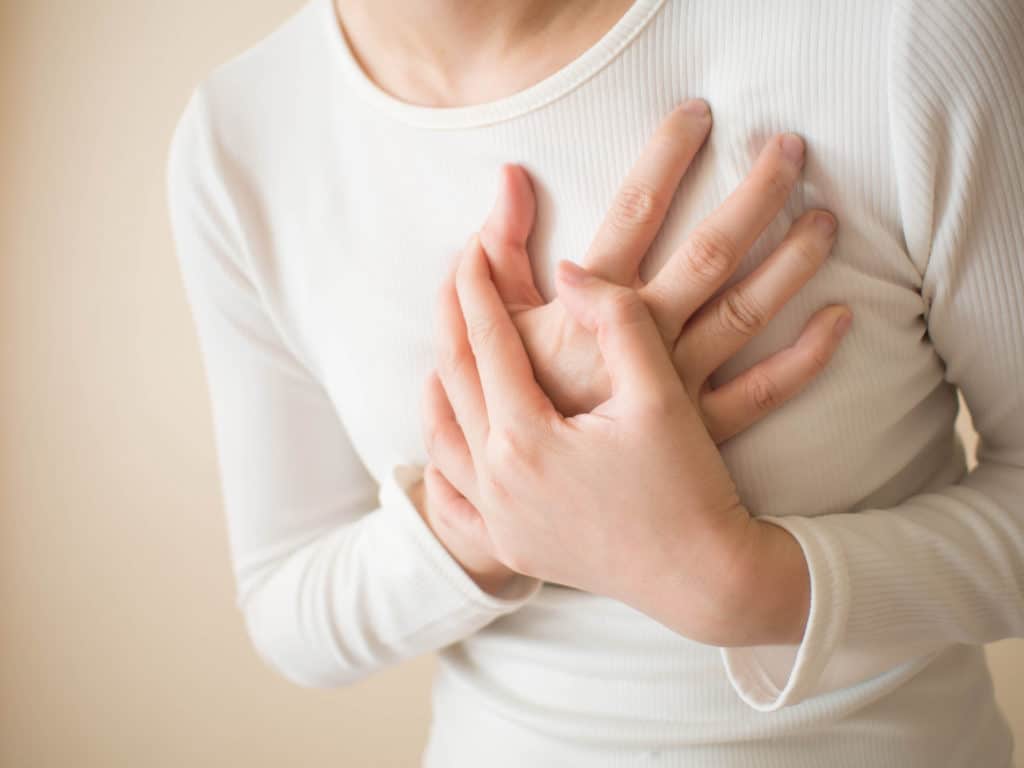
Table of Contents
Breast pain, sensitive breasts, and breast tenderness are some of the first symptoms of pregnancy, usually felt as early as within the first two weeks after the conception of the baby. As your body undergoes a massive surge of hormones to prepare for the baby, sore boobs come along as an unwelcome guest, peaking specifically in the first trimester.
The pain and tenderness felt in the breasts occur primarily since your hormones are at work to prepare your breasts for breastfeeding to happen at the end of the pregnancy. The boobs essentially begin to grow as your hormones stimulate the growth of milk-producing glands; and though this may be painful, it’d most likely give you a stunning cleavage too!
Breast Changes During Pregnancy
The changes in the breast during pregnancy take place throughout the pregnancy, the changes in each phase are different from the other. Here’s what’s happening to your breasts trimester-by-trimester throughout the pregnancy.
Breast Changes During Pregnancy: First Trimester Of Pregnancy
Breast changes in the early days of conception (during trimester one) are the most common and also one of the first signs of conception. While all women are different and hence experience varied breast changes, here are the most common breast changes during the first trimester–
- Rapid breast growth in terms of size could be experienced in the early weeks. Once you notice the changing size, it is advised to not use your regular bras and instead shift to a comfortable maternity bra or non-wired sports bra.
- As the hormone levels shoot up, they cause your nipples to become sensitive and tender.
- While most moms experience a dip in the tenderness after the first trimester, some women might experience the soreness up until the end of the pregnancy.
- Some moms might also exhibit noticeable blue veins as a result of the veins having to pump all the extra blood into their breasts.
Breast Changes During Pregnancy: Second Trimester Of Pregnancy
The most common breast changes during the second trimester-
- The second trimester is marked at the 15th week into pregnancy and onwards.
- The soreness of the boobs will, in most cases, go down in trimester two as compared to the kind of pain felt during the first semester.
- By this time, the milk-producing cells in your breasts are in full swing, and around the 22nd week, they actually start to produce milk (that will be reabsorbed into the body and let out only after the baby takes birth).
- Your nipples and areolas (the circled area of skin around your nipples) become darker and bigger.
- Some women might also notice little, pimple-like bumps on the areola called ‘Montgomery’s tubercles.’
- Fun fact: These bumps or Montgomery’s tubercles actually produce natural moisturizing oil to avoid soreness and potential infections during breastfeeding. Hence, make sure that you do not strip these natural oils from your nipples. Avoid using harsh soap or scrubs.
- Nipple discharge, a common discharge from the breasts, especially during nipple stimulation, might become more evident towards the end of the second trimester. The discharge from the nipples may vary from creamy-white to, yellow, green, or even brown in color.
Breast Changes During Pregnancy: Third Trimester Of Pregnancy
The most common breast changes during the third trimester-
- Breast soreness and tenderness can be expected to return in the third trimester, as in the first trimester.
- Since your breast size would also have most likely increased by now, wearing wire-free, comfortable cotton bras or a cotton sports bra might help avoid breast pain and ligament damage.
- Ensure that you use well-fitted bras since your cup size, as well as your band size, will change once the ribcage begins to expand to make room for the baby.
- You may also notice a whitish-yellow milky liquid oozing out of your breasts, called colostrum or early breast milk.
- Pro tip: nursing pads inside your bra can help mask the appearance of damp patches on your top due to colostrum.
- “Bloody nipple,” defined as a discharge of blood from the nipple, might also take place during the final weeks of the term as a result of expanding milk ducts or as a sign of a blocked duct. Reach out to your doctor if you notice a bloody nipple to rule out the possibility of a blockage.
- Nipple discharge may become more frequent.
Breast Changes post-childbirth: What Happens To Your Breasts After Delivery?
Having established what happens to your breasts trimester-on-trimester, it is only obvious to say that your breasts will undergo monumental changes post-delivery too. So, what exactly is happening to your boobs after the baby makes its grand entry into the world?
Here are the changes taking place in your breasts right after delivery-
- You can expect your breasts to appear fuller and firmer within two to four days post-childbirth. This change takes place as your baby gets ready to breastfeed. The amount of increased blood flow and circulation around the breast surges and so does the lymphatic fluid within the breasts.
- Besides, your pregnancy hormones also suddenly dip down as the baby is born to allow the breast-producing hormones to take over. Once the baby has been born and the placenta has been delivered, this will trigger the breast milk.
- A certain level of discomfort and pain might also be felt in the breasts (referred to as engorgement), which typically fades away within a few days.
Here Are The Changes Taking Place In Your Breasts During Lactation-
Your nine long months of pregnancy are over, the baby has been born, your body seems to start feeling more familiar, just like the pre-term days, you have also now been breastfeeding your baby for some time. But through this all, what is happening to your breasts?
- After delivery, during lactation, your breasts may begin to feel larger and heavier, owing to the storage of the baby’s food aka breastmilk.
- This fullness will most likely be most noticeable right before a feed.
- Within the first six months post-delivery, you can expect your breasts to return to a smaller size as you begin to lose the fatty tissue in the breast.
By the time your baby celebrates their its first birthday, your breasts will most likely return to the original, pre-pregnancy size.
Here Are The Changes Taking Place In Your Breasts After Weaning-
Weaning is defined as the process of introducing a baby to full-size human foods. It is the phase of transition from a mother’s milk or formula milk to actual food. So now that you have introduced your baby to proper food, do not breastfeed them anymore, what is happening to your breasts?
- Once you stop breastfeeding, regardless of what month it is, you can expect to notice a reverse in breast changes from when lactation started.
- This basically means that you can expect your breasts to return to similar to preconception size.
- Any lingering signs of soreness or pain will also diminish and you will not feel the fullness in your breasts anymore.
Breast Pain In Early Pregnancy vs Breast Pain As PMS Symptom
While breast pain indeed is an early sign of pregnancy, it is important to understand that breast discomfort does not always mean pregnancy. It might as well occur as a symptom of premenstrual syndrome (PMS) or due to various other reasons like lack of physical exercise. In some cases, consistent breast pain could also be indicative of a serious underlying condition. It is recommended to get your breasts examined if the breast pain lingers for normal than usual.
Having said that, it is for a fact that the symptoms of early conception are weirdly similar to the symptoms of the period. So how does one differentiate pregnancy from PMS? If you are a woman who has been experiencing soreness in your breasts through all your periods, you most likely are not pregnant and are just about to experience your periods. However, the only definitive way to rule out breast pain as a symptom of pregnancy is to either wait out for periods to arrive or to take a test. In some cases, women may experience one or two days of light spotting with no following period. This sporting might be indicative of implantation bleeding and pregnancy.
How To Ease Breast Pain During Pregnancy?
Breast soreness is a reality that you should be prepared to deal with throughout your pregnancy. However, there are some ways to deal with the discomfort better-
- Gently massage your breasts with rich lotions and essential oils. As the breast skin stretches, you may feel irritation or a scratchy feeling which can also be tackled with a light massage. You could also use anti-stretch mark creams or oils. (Having your partner do this for you could be a good idea too, just that, do not forget to give them a heads-up about the potential nipple discharge as a result of stimulation).
- Investing in a properly-fit maternity bra could also help tackle the pain. Look for a bra that offers good support, has wide straps, has adjustable closures, is not wired, and is preferably made of cotton with a seam-free design near the nipple.
Final Thoughts: Are Sore Breasts A Sign Of Worry?
Sore boobs can be a sign of worry or not depending on a lot of factors and body changes. If you experience sore boobs before or during your period, there’s obviously nothing to worry about as your hormones are at play. Likewise, if you experience sore, tender, sensitive boobs during pregnancy, there again is nothing to worry about.
However, it is recommended to conduct self-examination on your breasts from time to time, especially if your breasts tend to hurt beyond comfortable endurance or the pain takes place rather frequently. You should feel your breasts and look out for the potential formation of a lump; the said lumps, though in most cases are benign or harmless, may be cancerous tumors in some.
Breast Changes During Pregnancy FAQs
1) What kind of breast pain indicates pregnancy ?
2) How soon do breasts change when pregnant ?
Reviewed By-

Brandi Nicole, Lactation Consultant
Brandi Nicole is a pediatric nurse, a postpartum doula, and an international board-certified lactation consultant. She is a proud member of the International Lactation Consultant Association, the United States Lactation Consultant Association, and the Bay Area Lactation Associates.




